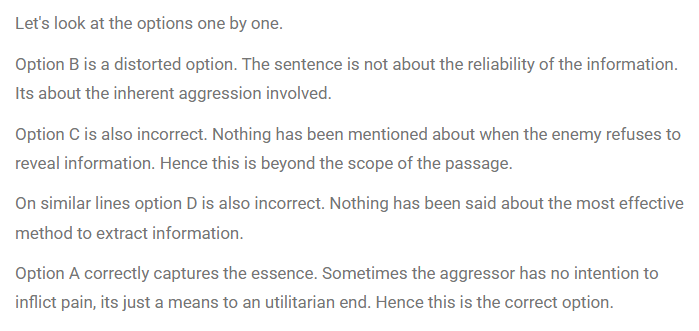CAT RC Questions | CAT RC Based on Humanities questions
FundaMakers is the Best CAT Online Coaching In India. Now prepare for CAT anytime with FundaMakers. We provide well-ordered syllabus coverage for both offline and online CAT preparation batches. FundaMakers brings to you the power-packed, well-structured CAT previous year question bank with more than 4000+ CAT Past Year questions. In the VARC section, one of the most frequently asked questions is from the topic- Reading Comprehension. Reading Comprehension turns out to be an important part of the VARC section from which over 60-70% of the questions are based on RC in the CAT Exam.
FundaMakers as a team has taken a painstaking step to bring you all the video solutions of the Reading Comprehension asked in the Previous Year CAT exam. CAT question bank offered by FundaMakers is a power-packed topic-wise compilation of the entire CAT previous year questions. Questions from the Reading Comprehension topic are some of the most scoring questions in the VARC section. To maximize your CAT score make use of FundaMakers CAT Question Bank. “Questions from CAT previous years” examination papers have been incorporated. Let’s get started with CAT Past Year Reading Comprehension Questions.
Comprehension
Directions for question: Read the passage carefully and answer the given questions accordingly
Aggression is any behavior that is directed toward injuring, harming, or inflicting pain on another living being or group of beings. Generally, the victim(s) of aggression must wish to avoid such behavior in order for it to be considered true aggression. Aggression is also categorized according to its ultimate intent. Hostile aggression is an aggressive act that results from anger, and is intended to inflict pain or injury because of that anger. Instrumental aggression is an aggressive act that is regarded as a means to an end other than pain or injury. For example, an enemy combatant may be subjected to torture in order to extract useful intelligence, though those inflicting the torture may have no real feelings of anger or animosity toward their subject. The concept of aggression is very broad, and includes many categories of behavior (e.g., verbal aggression, street crime, child abuse, spouse abuse, group conflict, war, etc.). A number of theories and models of aggression have arisen to explain these diverse forms of behavior, and these theories/models tend to be categorized according to their specific focus. The most common system of categorization groups the various approaches to aggression into three separate areas, based upon the three key variables that are present whenever any aggressive act or set of acts is committed. The first variable is the aggressor him/herself. The second is the social situation or circumstance in which the aggressive act(s) occur. The third variable is the target or victim of aggression.
Regarding theories and research on the aggressor, the fundamental focus is on the factors that lead an individual (or group) to commit aggressive acts. At the most basic level, some argue that aggressive urges and actions are the result of inborn, biological factors. Sigmund Freud (1930) proposed that all individuals are born with a death instinct that predisposes us to a variety of aggressive behaviors, including suicide (self directed aggression) and mental illness (possibly due to an unhealthy or unnatural suppression of aggressive urges). Other influential perspectives supporting a biological basis for aggression conclude that humans evolved with an abnormally low neural inhibition of aggressive impulses (in comparison to other species), and that humans possess a powerful instinct for property accumulation and territorialism. It is proposed that this instinct accounts for hostile behaviors ranging from minor street crime to world wars. Hormonal factors also appear to play a significant role in fostering aggressive tendencies. For example, the hormone testosterone has been shown to increase aggressive behaviors when injected into animals. Men and women convicted of violent crimes also possess significantly higher levels of testosterone than men and women convicted of non violent crimes. Numerous studies comparing different age groups, racial/ethnic groups, and cultures also indicate that men, overall, are more likely to engage in a variety of aggressive behaviors (e.g., sexual assault, aggravated assault, etc.) than women. One explanation for higher levels of aggression in men is based on the assumption that, on average, men have higher levels of testosterone than women.
CAT/2020.2
Question . 52
“[A]n enemy combatant may be subjected to torture in order to extract useful intelligence, though those inflicting the torture may have no real feelings of anger or animosity toward their subject.” Which one of the following best explicates the larger point being made by the author here?
Explanatory Answer
Method of solving this CAT RC Question from RC Based on Humanities question
Correct Option: A

Hey!
Worried about IIM calls due to your marks in 10th,12th, and Graduation?
Don't worry! Know your chances of getting an IIM Call based on your profile with our:-
Profile Professor: https://fundamakers.com/profile-professor/

5 Must- NOT-Dos during CAT Preparation.
- Do not treat CAT as 'Everything'.
- Do not quit your job for CAT exam preparation.
- Learning till The Eleventh hour instead of doing proper revision.
- Not checking the syllabus thoroughly.
- Piling up multiple books.
Click To Read:- Common mistakes made by CAT aspirants during preparation.
FundaMakers- Best Online and Offline CAT Online Preparation Institute in India
For any CAT Preparation related query, reach out to us at 9598333344.